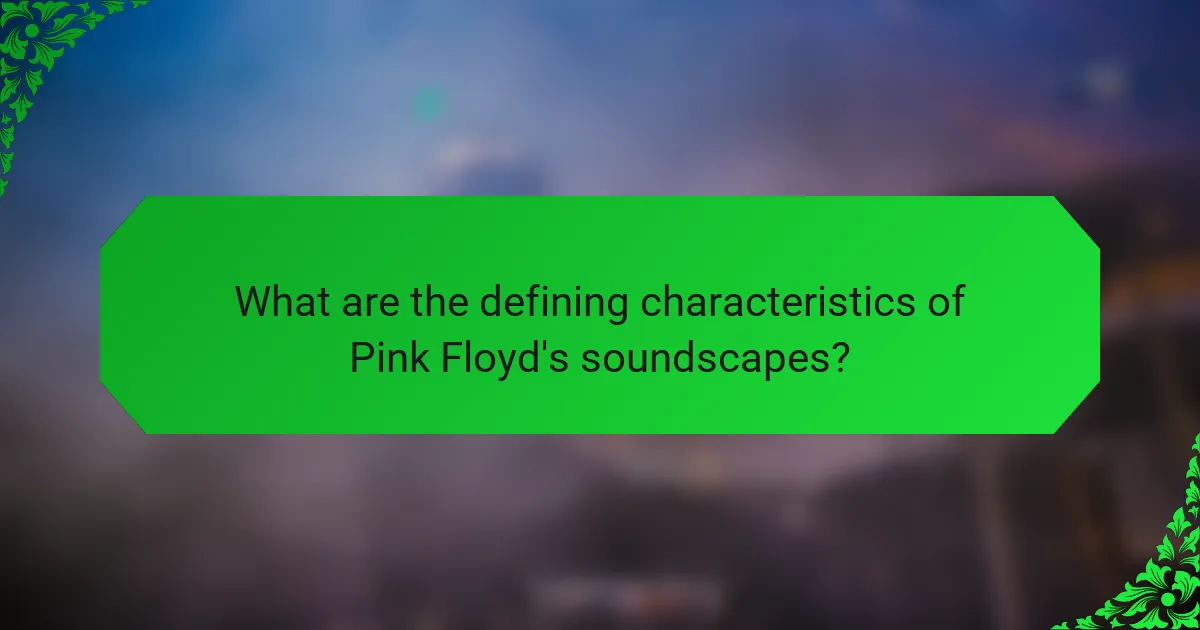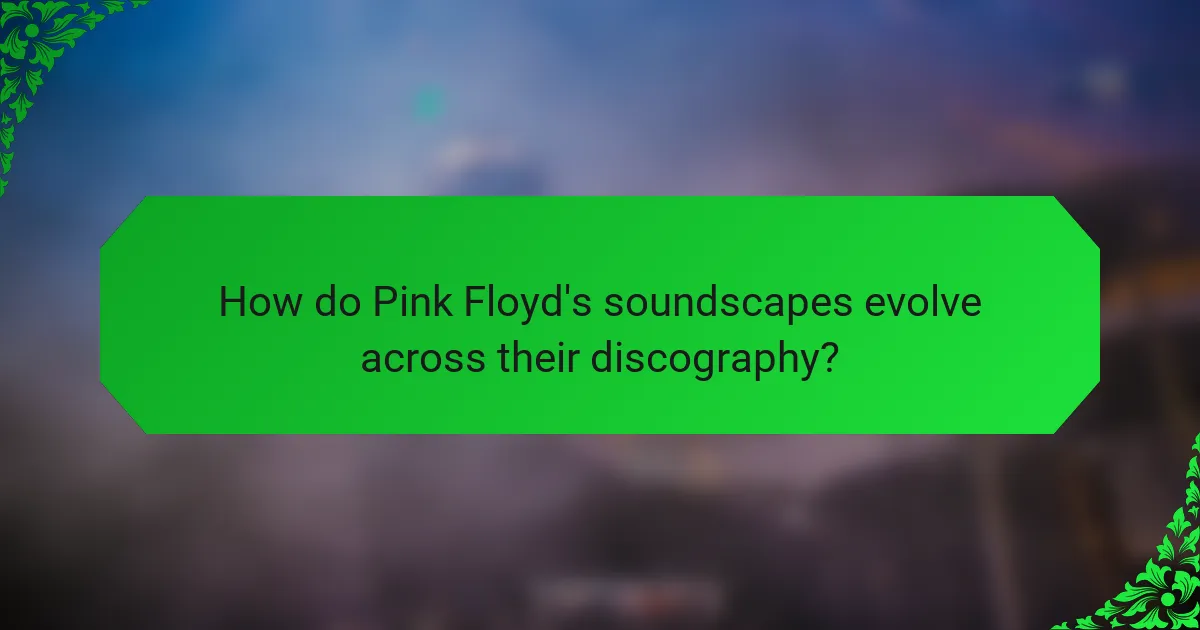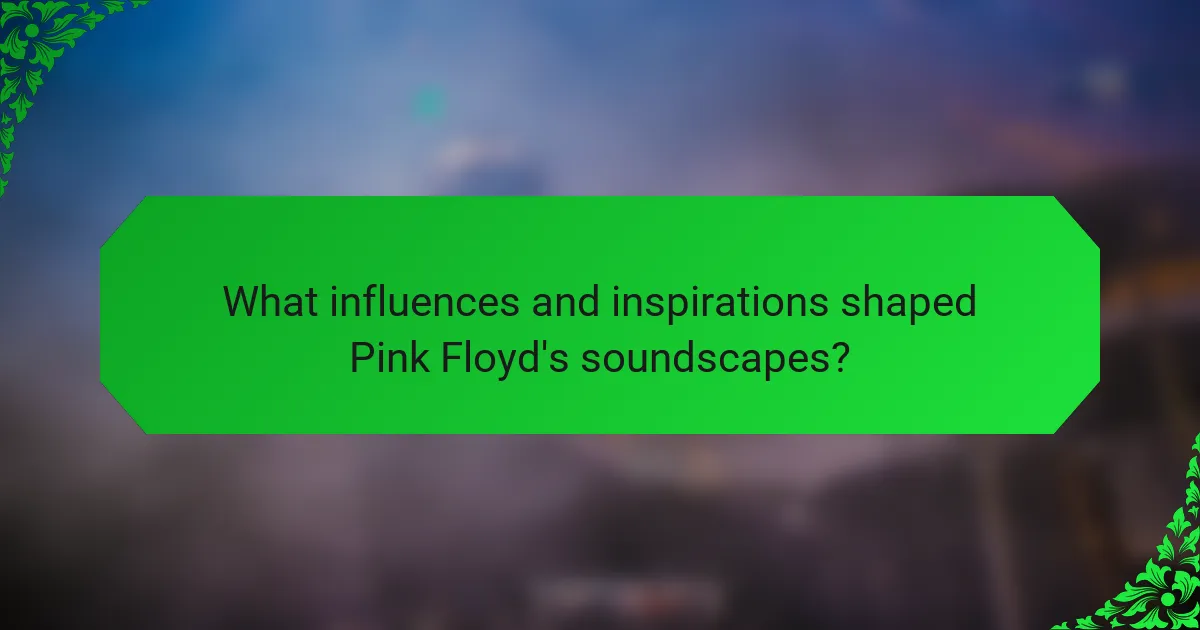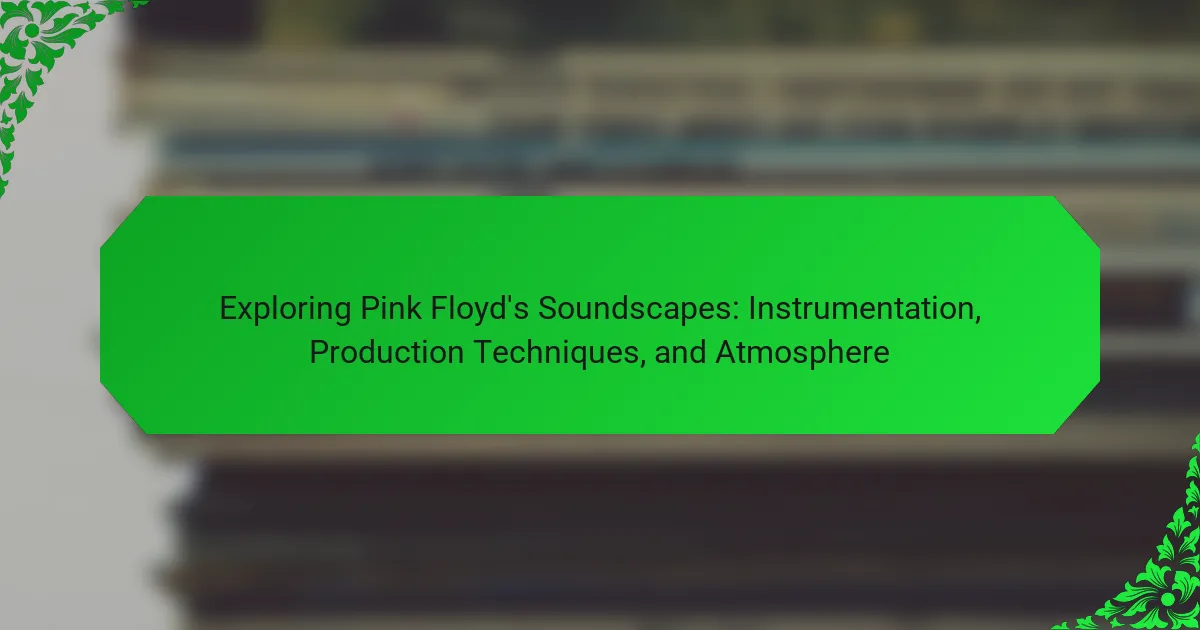Pink Floyd is a renowned rock band known for their innovative soundscapes characterized by atmospheric textures and advanced production techniques. Their music incorporates synthesizers, extensive guitar effects, and lengthy instrumental sections that explore complex themes and emotions. This article examines the evolution of Pink Floyd’s sound across their discography, highlighting key albums such as “The Piper at the Gates of Dawn,” “The Dark Side of the Moon,” and “The Division Bell.” It also discusses the influences that shaped their music, including blues, psychedelia, and literary themes, as well as the collaboration with notable producers. Overall, the article provides an in-depth look at the instrumentation, production techniques, and atmospheric elements that define Pink Floyd’s unique sonic identity.

What are the defining characteristics of Pink Floyd’s soundscapes?
Pink Floyd’s soundscapes are characterized by their use of atmospheric textures and innovative production techniques. The band often employs synthesizers to create immersive sound environments. Gilmour’s guitar work features extensive use of reverb and delay, enhancing emotional depth. Their compositions frequently include lengthy instrumental sections, allowing for exploration of musical themes. The integration of spoken word and sound effects adds layers to their sonic palette. Concept albums like “The Dark Side of the Moon” showcase thematic cohesion throughout the tracks. Their music often reflects philosophical themes, enhancing the listening experience. Overall, Pink Floyd’s soundscapes blend rock, psychedelia, and progressive elements, defining their unique sonic identity.
How does instrumentation shape Pink Floyd’s unique sound?
Instrumentation plays a crucial role in shaping Pink Floyd’s unique sound. The band utilizes a diverse array of instruments, including electric guitars, synthesizers, and orchestral elements. David Gilmour’s guitar work features distinctive effects like delay and reverb, creating a spacious sound. Richard Wright’s use of keyboards adds layers of texture and atmosphere. The incorporation of unconventional instruments, such as the saxophone and tape loops, further enhances their sonic landscape. Pink Floyd’s approach to instrumentation allows for dynamic shifts within their compositions. This results in a blend of rock, progressive, and experimental sounds. Their albums, like “The Dark Side of the Moon,” exemplify how instrumentation contributes to thematic depth and emotional resonance.
What instruments are most commonly used in Pink Floyd’s music?
Pink Floyd commonly uses guitars, keyboards, drums, and bass in their music. David Gilmour’s electric guitar is a defining element of their sound. Richard Wright frequently plays keyboards, including the organ and synthesizers. Nick Mason’s drumming provides a rhythmic foundation throughout their albums. Roger Waters primarily plays bass guitar, contributing to the band’s unique style. Their use of synthesizers, especially in albums like “The Dark Side of the Moon,” enhances their atmospheric sound. Additionally, they incorporate various sound effects and tape loops to create immersive experiences. These instruments collectively shape Pink Floyd’s distinct sound.
How do specific instruments contribute to the overall atmosphere?
Specific instruments shape the overall atmosphere by creating distinct sound textures and emotional responses. For example, the use of synthesizers in Pink Floyd’s music adds layers of depth and an otherworldly quality. Guitars often deliver haunting melodies that evoke feelings of nostalgia or melancholy. Drums provide a rhythmic foundation that can either energize or calm the listener. Additionally, the choice of instruments influences the dynamics of a piece, guiding the listener’s emotional journey. The combination of these elements results in a rich auditory experience that enhances the thematic content of the music.
What role does production technique play in Pink Floyd’s sound?
Production technique is crucial in defining Pink Floyd’s sound. The band utilized innovative recording methods to create their unique auditory experience. Techniques such as multi-tracking allowed for the layering of sounds, enhancing depth and complexity. They employed analog synthesizers, which contributed to their signature atmospheric quality. The use of sound effects, like tape loops and reverb, added an immersive element to their music. Additionally, the integration of studio experimentation played a significant role in their creative process. Albums like “The Dark Side of the Moon” exemplify the impact of production techniques on their overall sound. The meticulous attention to detail in production helped establish Pink Floyd as pioneers in the progressive rock genre.
What innovative production methods did Pink Floyd utilize?
Pink Floyd utilized innovative production methods such as multitrack recording and tape manipulation. They were pioneers in the use of studio effects to create a unique sound. For example, they employed sound collages and non-traditional instruments. Their album “The Dark Side of the Moon” showcased these techniques extensively. They used synthesizers and sampled sounds to enhance their music. The band also incorporated dynamic range and spatial effects in their recordings. These methods contributed significantly to their atmospheric soundscapes. Their experimentation set new standards in music production.
How do these techniques enhance the listening experience?
These techniques enhance the listening experience by creating immersive soundscapes. The use of layered instrumentation adds depth to the music. This layering allows listeners to discover new details with each listen. Production techniques, such as panning and reverb, create a spatial effect. This spatial effect makes the listener feel surrounded by the music. Additionally, the dynamic range in Pink Floyd’s tracks evokes emotional responses. The contrast between soft and loud passages keeps the listener engaged. Overall, these techniques contribute to a rich auditory experience that captivates audiences.
What themes and emotions are conveyed through Pink Floyd’s soundscapes?
Pink Floyd’s soundscapes convey themes of alienation, introspection, and existential angst. Their music often evokes emotions of melancholy and nostalgia. Songs like “Comfortably Numb” illustrate feelings of disconnection from reality. The use of atmospheric instrumentation enhances the sense of isolation. Tracks such as “Wish You Were Here” express longing and loss. The band employs innovative production techniques to create immersive experiences. Their soundscapes often reflect societal critiques and personal struggles. Overall, Pink Floyd’s music resonates deeply with listeners, capturing complex emotional states.
How does the atmosphere in their music reflect their lyrical themes?
The atmosphere in Pink Floyd’s music profoundly reflects their lyrical themes. Their soundscapes often create a sense of isolation and introspection. For example, the use of reverb and echo enhances feelings of distance and longing. In tracks like “Comfortably Numb,” the ethereal guitar solos mirror themes of alienation. The incorporation of ambient sounds creates a surreal environment that complements their exploration of existential questions. The dynamic shifts in volume and intensity reflect emotional highs and lows in their lyrics. Overall, the atmospheric elements serve to deepen the listener’s connection to the thematic content.
What emotional responses do listeners typically have to their soundscapes?
Listeners typically experience a range of emotional responses to soundscapes. These responses can include feelings of nostalgia, tranquility, or even anxiety. Soundscapes often evoke memories tied to specific auditory cues. For instance, ambient sounds can create a sense of calm or relaxation. Conversely, dissonant elements may induce tension or unease. Research indicates that soundscapes significantly impact mood and emotional well-being. A study published in the Journal of Environmental Psychology found that natural soundscapes can lower stress levels and enhance positive emotions. Thus, the emotional responses to soundscapes are diverse and can vary based on individual experiences and context.

How do Pink Floyd’s soundscapes evolve across their discography?
Pink Floyd’s soundscapes evolve significantly throughout their discography. Early albums like “The Piper at the Gates of Dawn” feature psychedelic elements and experimental instrumentation. As they progressed, albums such as “The Dark Side of the Moon” introduced more complex arrangements and thematic cohesion. The use of synthesizers and advanced production techniques became prominent in “Wish You Were Here.” In later works, like “The Division Bell,” their soundscapes incorporated digital elements and a polished production style. Each album showcases a shift in instrumentation and atmosphere, reflecting their artistic growth and experimentation.
What changes in instrumentation are evident in their albums?
Pink Floyd’s albums exhibit significant changes in instrumentation over time. Early works feature traditional rock instruments like guitars, bass, and drums. As they progressed, they began incorporating synthesizers and electronic elements. The album “The Dark Side of the Moon” introduced advanced studio techniques and layered soundscapes. In “Wish You Were Here,” acoustic guitars and synthesizers became prominent. Their later albums, such as “The Division Bell,” included more digital instrumentation and sampling. This evolution reflects their experimentation with sound and technology throughout their career.
How does the use of technology evolve throughout their career?
The use of technology in Pink Floyd’s career evolved significantly over time. In the early years, they primarily used traditional instruments and analog recording techniques. As the band progressed, they began incorporating innovative effects and synthesizers. The release of “The Dark Side of the Moon” marked a turning point, showcasing advanced studio techniques and multi-track recording. Their experimentation with sound manipulation and tape effects became more pronounced in albums like “Wish You Were Here.” In the late 1970s and 1980s, they embraced digital technology, integrating synthesizers and computer-based production. This evolution allowed for more complex soundscapes and atmospheric compositions. Throughout their career, Pink Floyd consistently pushed the boundaries of technology to enhance their musical expression.
What are the significant milestones in their musical development?
The significant milestones in Pink Floyd’s musical development include the formation of the band in 1965. They released their debut album, “The Piper at the Gates of Dawn,” in 1967, showcasing their early psychedelic sound. The album “The Dark Side of the Moon,” released in 1973, marked a turning point, achieving commercial success and critical acclaim. Their 1975 album, “Wish You Were Here,” further established their artistic vision. The release of “The Wall” in 1979 introduced a rock opera format, solidifying their influence in music. The band continued to evolve with “A Momentary Lapse of Reason” in 1987, reflecting their adaptation to changing musical landscapes. Each of these milestones contributed to their legacy as pioneers in progressive rock.
How do production techniques vary between different albums?
Production techniques vary significantly between different albums. Each Pink Floyd album showcases unique approaches to sound engineering and production. For instance, “The Dark Side of the Moon” employed multi-track recording and innovative use of synthesizers. This album featured seamless transitions between tracks, creating a cohesive listening experience. In contrast, “The Wall” utilized a more theatrical production style, integrating sound effects and narrative elements. The band’s experimentation with studio technology, such as tape loops and reverb, also differed across albums. “Wish You Were Here” highlighted acoustic elements and live recordings, emphasizing emotional resonance. Overall, the evolution of production techniques reflects the band’s artistic growth and experimentation over time.
What unique production choices define each era of their music?
Each era of Pink Floyd’s music is defined by distinct production choices. In the early years, they utilized experimental sound effects and tape manipulation. This approach is evident in albums like “The Piper at the Gates of Dawn.” The band’s transition to the 1970s introduced elaborate studio techniques and concept-driven compositions. “The Dark Side of the Moon” showcased multi-track recording and innovative use of synthesizers. The later era featured a more polished sound, emphasizing digital production. “A Momentary Lapse of Reason” exemplifies this shift with its use of digital synthesizers and sampling. Each era reflects a progression in technology and artistic vision, shaping their unique sound.
How do these choices impact the overall sound and feel of the albums?
The choices in instrumentation and production techniques significantly impact the overall sound and feel of Pink Floyd’s albums. Their use of synthesizers creates atmospheric soundscapes that evoke emotional responses. Layered guitar effects contribute to a rich, immersive sound. The decision to incorporate unconventional time signatures adds complexity to the music. Production techniques like analog recording enhance warmth and depth in the audio. These elements combine to create a unique auditory experience. The band’s experimentation with sound design sets them apart in the progressive rock genre. Each choice reinforces the thematic content of the albums, enhancing listener engagement.

What influences and inspirations shaped Pink Floyd’s soundscapes?
Pink Floyd’s soundscapes were shaped by various influences and inspirations. The band’s early work was influenced by the British blues scene. They incorporated elements of psychedelia, which was prevalent in the 1960s. Experimental techniques, such as tape loops and synthesizers, were also significant. The use of ambient sounds added depth to their compositions. Literary influences, particularly from authors like George Orwell, inspired thematic elements in their music. Additionally, the band’s personal experiences and societal issues informed their lyrical content. Collaboration with innovative producers, like Alan Parsons, enhanced their sonic experimentation. Each of these factors contributed to the unique sound that defines Pink Floyd.
How did the cultural and historical context influence their music?
Cultural and historical context significantly influenced Pink Floyd’s music. The band’s formation in the 1960s coincided with social upheaval and counterculture movements. This era was marked by anti-establishment sentiments and experimentation in art and music. Pink Floyd’s early works reflected the psychedelic culture, utilizing innovative sound effects and extended instrumental sections. The Vietnam War and political unrest also shaped their lyrics, which often addressed themes of alienation and existential despair. The release of “The Dark Side of the Moon” in 1973 coincided with rising consumerism and mental health awareness. This album’s exploration of human experience resonated with listeners during a time of societal change. Additionally, technological advancements in recording influenced their production techniques, allowing for more complex soundscapes. Overall, Pink Floyd’s music serves as a reflection of the cultural and historical landscape of their time.
What external factors contributed to their distinctive sound?
External factors that contributed to Pink Floyd’s distinctive sound include technological advancements and cultural influences. The use of innovative studio techniques, such as tape manipulation and synthesizers, shaped their music. Collaborations with avant-garde artists expanded their creative boundaries. The socio-political climate of the 1960s and 1970s influenced their lyrical themes and soundscapes. The rise of psychedelic rock also played a significant role in their musical direction. Their engagement with visual arts created a holistic experience that complemented their sound. These elements combined to form a unique auditory landscape that defined their work.
How did other artists and genres impact their musical style?
Other artists and genres significantly influenced Pink Floyd’s musical style. The band drew inspiration from the avant-garde movement, particularly through artists like John Cage. Their incorporation of electronic music elements was influenced by Kraftwerk and the burgeoning synth-pop scene. The use of blues and rock elements can be traced back to influences from artists like Bob Dylan and The Beatles. Additionally, psychedelia played a crucial role, with influences from bands such as The Byrds and The Doors. This eclectic mix shaped their experimental approach, leading to innovative soundscapes. The fusion of these diverse influences helped establish Pink Floyd’s unique identity in the music industry.
What are some notable collaborations that influenced their sound?
Pink Floyd’s sound was notably influenced by collaborations with various artists and producers. One significant collaboration was with producer Alan Parsons on “The Dark Side of the Moon.” His engineering expertise helped shape the album’s innovative sound. Another key collaborator was composer Richard Wright, whose keyboard work added depth to their music. The partnership with David Gilmour brought a distinctive guitar sound that became a hallmark of their style. Additionally, their collaboration with visual artist Storm Thorgerson enhanced the atmospheric elements of their albums. These collaborations collectively contributed to Pink Floyd’s unique sound and enduring legacy.
How did working with producers and other musicians enhance their soundscapes?
Working with producers and other musicians significantly enhanced Pink Floyd’s soundscapes. The collaboration allowed for diverse musical influences and innovative production techniques. Producers like Alan Parsons introduced advanced recording methods that created richer audio textures. This partnership also facilitated experimentation with sound effects and unconventional instruments. Contributions from various musicians added layers of complexity to their compositions. For instance, the use of synthesizers and orchestral arrangements expanded their sonic palette. Overall, these collaborations resulted in iconic albums that pushed the boundaries of rock music.
What practical tips can be learned from Pink Floyd’s approach to soundscapes?
Pink Floyd’s approach to soundscapes offers several practical tips for music creation. First, they emphasize the importance of layering sounds. This technique creates depth and richness in compositions. Second, they utilize unconventional instruments. Incorporating unique sounds can enhance the overall atmosphere. Third, they focus on dynamic contrasts. Varying volume and intensity keeps listeners engaged. Fourth, they experiment with effects and processing. Using reverb and delay can transform basic sounds into immersive experiences. Fifth, they integrate narrative elements. Telling a story through music adds emotional weight. Lastly, they encourage collaboration among band members. Diverse input fosters creativity and innovation. These strategies collectively contribute to creating captivating soundscapes.
How can aspiring musicians incorporate similar techniques into their work?
Aspiring musicians can incorporate similar techniques by studying Pink Floyd’s use of atmospheric soundscapes. They should experiment with layering different instruments to create depth. Utilizing effects like reverb and delay can enhance the overall ambiance. Musicians can also explore unconventional song structures to evoke emotion. Incorporating found sounds or field recordings adds unique textures. Collaborating with other artists can bring diverse influences into their work. Analyzing the production techniques used in albums like “The Dark Side of the Moon” provides practical insights. These approaches can help musicians develop their distinctive sound while paying homage to Pink Floyd’s innovative style.
What lessons can be drawn from their innovative use of instrumentation and production?
Innovative use of instrumentation and production by Pink Floyd demonstrates the importance of experimentation in music. Their incorporation of diverse instruments, such as synthesizers and sound effects, expanded traditional rock boundaries. This approach led to unique soundscapes that enhanced emotional depth in their work. For instance, the use of the EMS Synthi AKS in “On the Run” created an immersive auditory experience. Additionally, their multi-layered production techniques allowed for complex arrangements and textures. The meticulous attention to detail in mixing and sound design contributed to their signature atmospheric quality. These practices illustrate how innovation can redefine a genre and engage listeners on multiple levels.
Pink Floyd is the primary entity of this article, which explores their distinctive soundscapes characterized by innovative instrumentation and production techniques. The article details how atmospheric textures, synthesizers, and dynamic instrumentation contribute to the band’s unique sound identity, highlighting key albums such as “The Dark Side of the Moon” and “Wish You Were Here.” It also examines the emotional themes conveyed through their music, the evolution of their sound across their discography, and the influence of external factors and collaborations on their sonic development. Additionally, practical insights are provided for aspiring musicians looking to incorporate similar techniques into their work.
